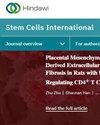基于肿瘤干细胞构建预测宫颈癌存活结果的7 mrnasi相关基因模型
IF 3.8
3区 医学
Q2 CELL & TISSUE ENGINEERING
引用次数: 0
摘要
背景。宫颈癌(CC)是最常见的女性恶性肿瘤之一。肿瘤干细胞(Cancer stem cells, CSCs)积极影响癌症患者的生存结局,但在宫颈癌中,肿瘤干细胞的作用机制仍不确定。方法。CC患者的RNA-seq数据及相关临床随访均来自TCGA。共识聚类筛选预后mrnasi相关基因并鉴定CC分子亚型,基于亚型中差异表达基因(DEGs)的重叠,采用LASSO和多变量Cox回归筛选预后相关基因并建立RiskScore系统。采用RiskScore对患者进行分组,各组间采用Kaplan-Meier (K-M)曲线分析预后,采用ROC曲线评价RiskScore的准确性。最后,通过评估TIDE评分和化疗药物IC 50值来评估RiskScore在免疫治疗/化疗反应中的潜在价值。结果。我们注意到低mRNAsi患者的生存期较短,然后确定了三种分子亚型(C1-3),其中C1预后最差,mRNAsi最低。最后,我们通过LASSO和Cox回归分析确定了7个预后相关基因(SPRY4、PPP1R14A、MT1A、DES、SEZ6L2、SLC22A3和CXCL8)。我们建立了一个定义为RiskScore的7基因模型来预测CC患者的预后。K-M曲线提示低RiskScore患者预后较好,ROC曲线提示RiskScore可以准确指导癌症患者的预后评价。这在GSE44001和GSE52903外部队列中也得到了证实。RiskScore低的患者对免疫治疗更敏感,RiskScore在预测CC患者免疫治疗反应方面表现出精确的评估能力。结论。CC干性与患者预后相关,基于干性特征构建的RiskScore是一个独立的预后指标,有望为免疫治疗提供指导,为CC临床实践提供新的思路。本文章由计算机程序翻译,如有差异,请以英文原文为准。
Construction of an Excellent 7 mRNAsi-Related Gene Model Based on Cancer Stem Cells for Predicting Survival Outcome of Cervical Cancer
Background. Cervical cancer (CC) is one of the most frequent female malignancy. Cancer stem cells (CSCs) positively affect survival outcomes in cancer patients, but in cervical cancer, the mechanism of tumor stem cells is still uncertain. Methods. RNA-seq data and related clinical follow-up of patients suffering from CC were from TCGA. Consensus clustering screened prognostic mRNAsi-related genes and identified molecular subtypes for CC. Based on the overlapping differentially expressed genes (DEGs) in subtypes, we employed LASSO and multivariate Cox regression to screen prognostic-related genes and established the RiskScore system. The patients were grouped by RiskScore, the prognosis was analyzed by the Kaplan-Meier (K-M) curve among the various groups, and the precision of the RiskScore was assessed by the ROC curve. Finally, the potential worth of RiskScore in immunotherapy/chemotherapy response was assessed by evaluating TIDE scores and chemotherapy drug
IC
50
values. Results. We noticed that patients with low mRNAsi had a shorter survival and then identified three molecular subtypes (C1-3), with the C1 having the worst prognosis and the lowest mRNAsi. Finally, we identified 7 prognostic-related genes (SPRY4, PPP1R14A, MT1A, DES, SEZ6L2, SLC22A3, and CXCL8) via LASSO and Cox regression analysis. We established a 7-gene model defined RiskScore to predict the prognosis of CC patients. K-M curve indicated that low RiskScore patients had improved prognosis, and ROC curves indicated that RiskScore could precisely direct the prognostic evaluation for those suffering from the cancer. This was also confirmed in the GSE44001 and GSE52903 external cohorts. Patients were more sensitive to immunotherapy if with low RiskScore, and RiskScore exhibited precise assessment ability in predicting response to immunological therapy in CC patients. Conclusion. CC stemness is associated with patient prognosis, and the RiskScore constructed based on stemness characteristics is an independent prognostic index, which is expected to be a guide for immunotherapy, providing a new idea for CC clinical practice.
求助全文
通过发布文献求助,成功后即可免费获取论文全文。
去求助
来源期刊

Stem Cells International
CELL & TISSUE ENGINEERING-
CiteScore
8.10
自引率
2.30%
发文量
188
审稿时长
18 weeks
期刊介绍:
Stem Cells International is a peer-reviewed, Open Access journal that publishes original research articles, review articles, and clinical studies in all areas of stem cell biology and applications. The journal will consider basic, translational, and clinical research, including animal models and clinical trials.
Topics covered include, but are not limited to: embryonic stem cells; induced pluripotent stem cells; tissue-specific stem cells; stem cell differentiation; genetics and epigenetics; cancer stem cells; stem cell technologies; ethical, legal, and social issues.
 求助内容:
求助内容: 应助结果提醒方式:
应助结果提醒方式:


